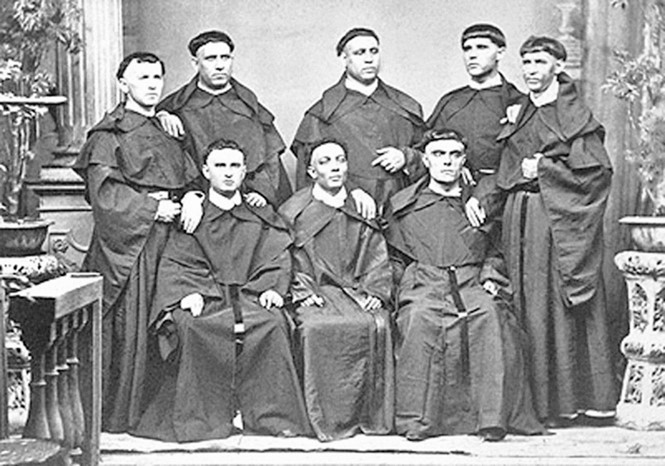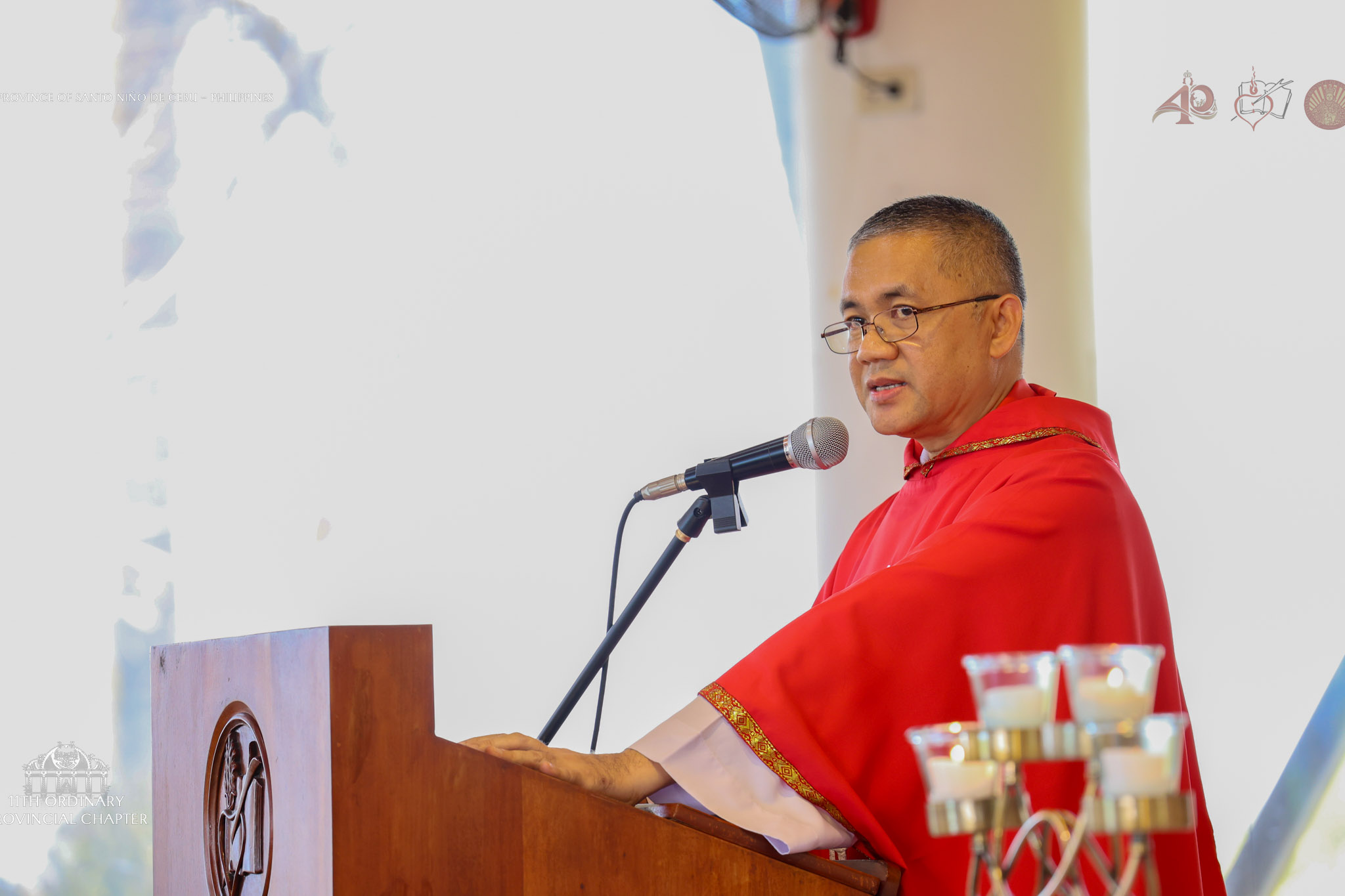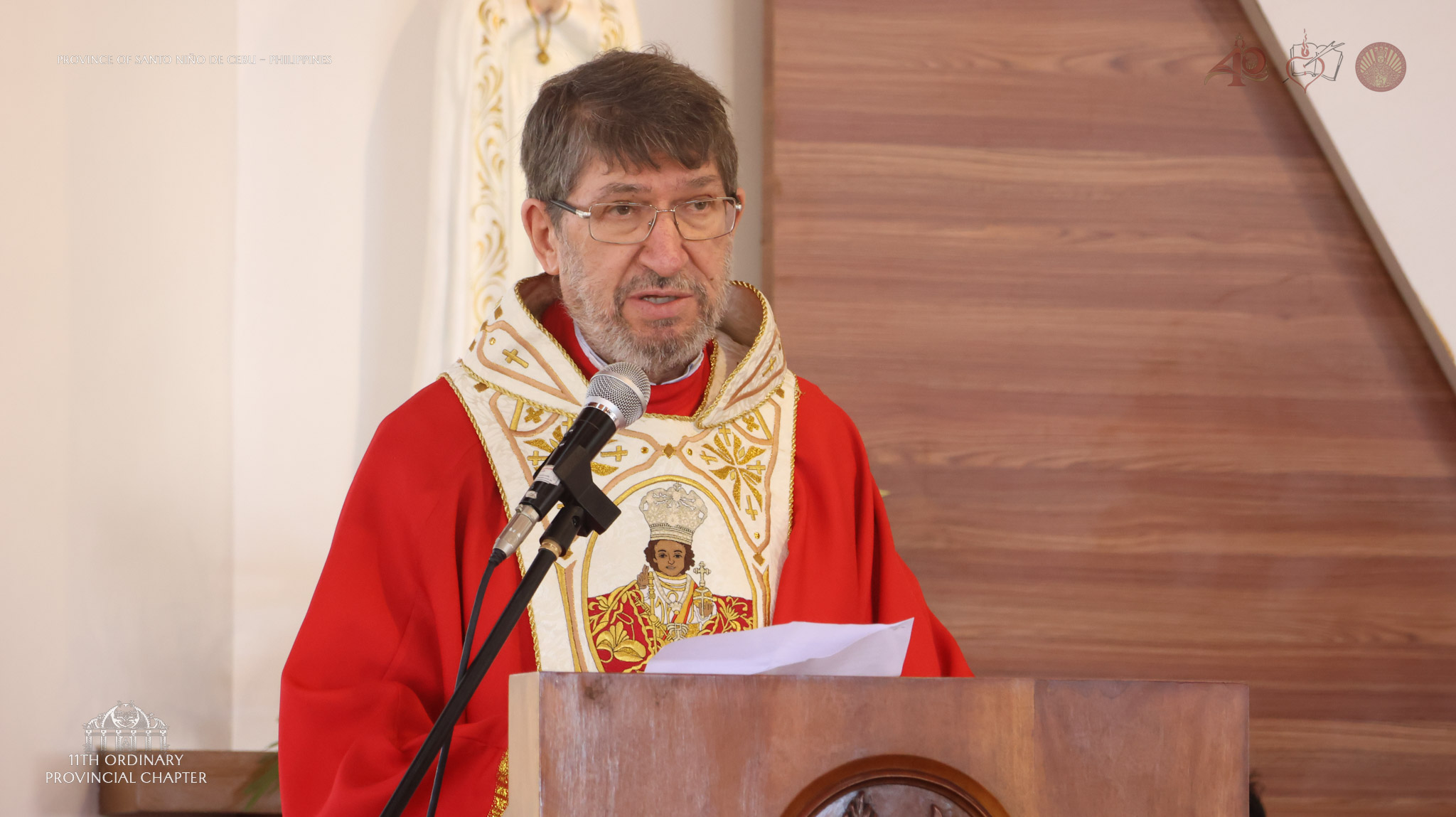(Note: This article “Augustinians in the Philippines (1565-1898)” was originally published in an APAC Bulletin in 1978. It was written by Fr. Pedro G. Galende, OSA)
The harvest was indeed great, the laborers few.
Fray Andres de Urdaneta, OSA, commissioned by royal order of King Philip II to launch and direct the expedition to the West Islands together with five ether conferrers, boarded the “Nao Capitana” on November 20, 1564. One of the Augustinians died at Acapulco, but the others made the trip – Fr. Andres de Urdaneta, Fr. Martin de Rada, Fr. Andres de Aguirre, Fr. Diego de Herrera and Fr. Pedro de Gamboa.
On April 27, 1565, the expedition landed on Cebu territory. Several overtures at friendship with the natives failed and Legazpi ordered the ship’s artillery to fire. The natives fled to the mountains. Inside one of the houses, a soldier named Juan Camus found an image of the Holy Child. It was reputedly the one given by Magellan to Rajah Humabon’s wife after her conversion. This incident fired in the Augustinians’ hope and courage in their mission of Christianizing the islands. Later their first house on a piece of land allotted by Legazpi himself was also dedicated to the Holy Child.
Fr. Urdaneta and Fr. Aguirre returned to Spain, while the three Augustinians, Fr. De Rada, Fr. Herrera and Fr. De Gamboa organized the Christianization of the islands. The first step was the founding of the City of Cebu.
Conversion to the new faith was easy during the early days in Cebu. The widowed niece of Rajah Tupas, together with her son, maids and servants, asked to be baptized by Fr, Herrera. She took the name of Isabel and later married a carpenter of the expedition. Many followed Isabel’s example and asked to be baptized. On March 1, 1568, Tupas himself was publicly baptized.
The missionaries proceeded toward Panay, reaching as far as Iloilo, and spreading throughout the whole island. On June 11, two more Augustinians arrived in Cebu-Alonso Jimenez and Juan de Alva, who was 70 years old. The arrival of these two new missionaries marked the beginning of the Augustinian province of the Most Holy Name of Jesus in the Philippines, which has stayed to the present. In a meeting of the missionaries, Diego de Herrera was elected superior provincial of the province in the islands, Martin de Rada was named superior of the house of Cebu, Fr. Jimenez was assigned to the island of Masbate, and Fr. Juan de Alva to Panay.
On May 19, the expedition commanded by Legazpi entered Manila with 200 Spaniards. Herrera was in the expedition, in behalf of the newly-established Augustinian province. A piece of land, “the most beautiful part; of the city,” was allotted by royal order to the Augustinians for the construction of the church and monastery residence for the priests. “Shortly after their arrival in Luzon, the Augustinians had already founded five houses in the Philippines: Cebu, Oton, Mindoro, Manila and Tondo,”
Private and official communications between religious and government officials showed an instability partly due to scarcity of personnel, distance from the mother country, and the menace of the Portuguese. Also it took time for them to realize that their mission was in the Philippines and not China or Japan, dreams of whose richness and vastness they had always harbored.
Christianization of Luzon
Periodic reports of the evangelization were made. Rada’s letter, dated 1572, states that “there are quite a good number of Christians right here in Manila, in Tondo, Lubao (Pampanga), Mindoro, Oton, Cebu, Vahali (?) and Bombon.” Further accounts give information on the new assignments of Augustinians to Laguna do Bay, Pasig, Calumpit and about the first monastery of Lubac. Another letter, dated 1575, reports on the new missions of Ilocos, Nueva Segovia, and some other additional towns in the provinces already administered by the Augustinians.
By 1575, there was a total of 18 towns founded by the Augustinians, 16 Augustinian houses, and 46 priests living in the Philippines. By the end of the 16th century, only 25 years after the arrival of the missionaries in the archipelago, the Augustinians had under their care some 111,720 souls out of a total of 667,612. By 1594, an account by Fr. Francisco de Ortega sent to the king spoke of 44 towns founded by the Augustinians, 102 priests and 244,000 sous under their care and some 55,000 catechumens. By 1760, the Augustinians had founded 99 towns.
The following years, more towns were founded, churches built, roads opened, bridges constructed, and schools established. At the end of the Spanish regime, the Augustinians had under their care the following provinces: Manila with 148,385 souls; Batangas, 209,884; Bulacan, 188,057; Nueva Ecija, 107,585; Pampanga, 243,246; Tarlac, 47,749; Iloilo, 342, 604; Concepcion, 45,065; Capiz, 106,953; Antique, 119,697; Cebu, 256,866; Ilocos Norte, 147,518; Ilocos Sur, 106,815; La Union, 118,983; Abra, 32,055. This makes a total of 2,221,462 souls in the care of the Augustinians distributed in 233 towns with 240 priests. There were records of 110,233 baptisms, 17,909 marriages, 67,508 deaths.
The Augustinian monastery opened its doors to anybody who wished to be an Augustinian, without any discrimination as to race or color. This was the decision reached by the provincial chapter of 1624, which left the provincial to accept even Japanese, if the circumstances so advised. “On April 30, 1575… the novitiate house of the Augustinians opened its doors to any native willing to become a religious.” According to an Augustinian chronicle, before 1600 there were 18 priests and cooperators professed in the monastery of San Agustin, out of which four were Spaniards, one Filipino, five Japanese, four from Oriental India, and three from New Spain.
The number of “professed” increased with the years. It was even feared that insufficient preparation might result from the rashness of the method, producing number rather than quality. This originated the so-called conflict of the “alternative,” which caused much damage to religious orders because of the general inclination to field foreign rather than native priests. It can generally be gathered from Jorde’s Catalogo that out of 213 professed in the Augustinian monastery of Manila no less than 86 were Philippine-born. According to Fr. Isacio Rodriguez in his The “Escorial” of the Philippines, there were no less than 100 Augustinians born in the Philippines.
Augustinians also organized very early a school in Cebu, ” first official center of learning in the Philippines,” the Santo Niño of Cebu school.
According to Fr. Medina, “they (Augustinians) had already from the start a school at the monastery (of Cebu); they taught the children reading, writing, and mathematics. Others were employed in the sacristy, taught how to serve Mass…”
During the following years schools opened and maintained in Arevalo, Malolos, San Nicolas, Manila, Tondo, Pasig, Taal, Lingayen, Bacoor, Betis, Lubao, Guadalupe, Candaba, Cordoba, San Joaquin, San Pablo, San Miguel de Mayumo, Jaro. This was not money-making endeavor but a complimentary course to the religious teaching patterned after the missionary experience in Mexico.
There was, likewise, another school established by the Augustinians in the monastery of Manila. “The glory of having attempted to found the first center of higher education, though unofficial in character and adapted to the necessities of the members of the order, may be attributed to the religious of San Agustin,” wrote trio Dominican Fr. Bazaco of the school founded by the Augustinians in Manila.
The school continued for years plagued with difficulties due mainly to the insistence of the provincials to send more and more missionaries to the parishes. The cultural peak of the school was reached with the publication of Blanco’s Flora de Filipinas: the work of the Augustinian Manuel Blanco, the scientist, with the cooperation of Frs. Celestino Fernandez-Villar, Antonio Lianos, Andres Naves and Ignacio Mercado (an Augustinian born in Parañaque, Philippines).
\Fr. Castro mentions as well one School of Arts and Theology that the order maintained in Manila, Guadalupe and Lubao. “Formerly,” says Fr. Castro, “this province maintained public schools of all sciences in Lubao, Guadalupe and Manila. As recorded in the books of the chapters, every three-year term there were professors nominated to teach Grammar, Arts and Theology, specially for the Schools of Manila and Cebu.” Fr. Castro adds that these schools continued until the arrival of the Jesuits, to whom the Augustinians entrusted the discipline of teaching in order to dedicate themselves more deeply to the parochial work.
The Augustinians were active in contributing personnel or money or provisions or recruiting soldiers in the provinces to fight off invading troops. In the attack against the Chinese pirate Limahong, who had plundered Manila and Pangasinan, Martin de Rada and Albuquerque went with the troops as chaplains. When the troops split into two battalions, one friar came to Manila, the other remained in Pangasinan.
The names of Francisco Valdes, Antonio Porras and Juan Gutierrez are given as valiant opponents of Van Noort when the Dutch commander came to disrupt trading between Spain and the Philippines. Of these, the most famous and legendary was Fr. Valdez, who had to swim to safety when his boat capsized.
Later on, it was an attack by the Chinese Juan Bautista de Vera, alias En-Kang, who had come to Manila to “exterminate the Spaniards,” and on October 3, 1603, set fire to the Tondo and Quiapo towns. Later, he was captured and hanged in a public square. Brother Antonio Flores distinguished himself by patrolling the Pasig River with the galiot of the San Agustin monastery and fighting off the Chinese junks.
Still another revolt was provoked by the Chinese in 1639. A document in the Archives of the Indies speaks of several Augustinians who battled against the Chinese invaders, recruiting volunteers and money from various nearby provinces and parishes.
The Augustinians showed the same patriotic fervor in the defense of the country in the various invasions of the Muslims in Panay and Cebu. They proved themselves the most quixotic defenders of the City of Manila against the British soldiers in 1762, due to which many of the Augustinians were taken as slaves on board British ships.
From early times, the Augustinians condemned the abuses by some Spanish soldiers of their Filipino servants, through the authority of the encomenderos. Herrera disapproved of the unchristian practice of slavery and its adverse effect on the teaching of religion.
Both the provincial chapters and the intermediate meetings of the councils reflect the concern of the missionaries for the complete and well-organized town with its corresponding visitas or jurisdictions. Several chapter resolutions speak of the convenience that the natives “stay in their towns, build their houses near the principal churches and the visitas allocated to the main parish.” They directed the construction of the bridges of Pasig, Pateros, Batangas, Lipa, Taal, and Lemery. Fr. Blanco introduced the loom and laundry business and the irrigation system in Bauan; Fr. Camañes organized the fish and salt industry in Betis; Fr. Valdez brought to Aliaga the mechanical saw operated by steam, the first in use in the Philippines; Fr. Ortiz taught the natives of Pasuquin and Pacay brick-making and the weaving cf cotton and linen.
Various attempts at establishing spiritual contact with the minorities of northern Luzon populating the mountains of Zambales, Pangasinan and Ilocos provinces were made by the Augustinians. The first attempt was made by Esteban Marin, who “reached far into the wild forests and was recompensed with quite a good many friends and conversions.” This amicable experience led Governor Tello to send, in 1601, an expedition to pacify and draw the tribes down into the towns. Fr. Marin volunteered to go in the forests to the natives’ dwellings. He was killed in this mission, Juan Pareia parish priest of Bantay, followed by another Augustinian mission composed of Jose Herice, Jacinto Rivera, Nicolas Fabro and Manuel de Madariaga also attempted missionary work in the Mountain Province.
Missionaries also worked among the Ilocos groups, although little was achieved until early 19th century. The final success was reserved for Fr. Bernardo Lago, who in May, 1823, made contact with the Tinggian and the Igorot, accompanied only by a Tagalog guide. Fr. Lago lived with them and learned their language. He taught them how to make houses out of strong materials by cutting down trees, how to pick the proper places for the location of towns, how to cultivate the land, how to make dams to irrigate the crops, and how to raise cattle to till the land.
Caring for children.
A new association of Christian ladies, or “damas,” worked under the direction of the Augustinian Fathers to alleviate suffering caused by the plague and torrential floods. It founded the Asilo de Nuestra de la Consolacion, which took care of orphans. As their increased, the Catholic damas approved a more ambitious plan: a school for arts and trades.
The first orphanage was built at San Marcelino Street. When the Paco building proved insufficient, the Augustinians transferred the girls to Mandaluyong and later on to a complex in Malabon.
The building in Malabon was officially inaugurated as School for Arts and Trades on February 1, 1890. It housed 150 orphans. The organizer of the project was Fr. Salvador Font, in cooperation with the Augustinian Sisters, who took care of the education of boys and girls. There was, aside from the dormitories, classrooms, laboratories, and room for carpentry and arts, a printing press, with lithography, binding and other facilities. The printing press was taken by the Aguinaldo forces and used for a time to print La Independencia. The complex was totally destroyed by the American forces in 1898.
The Augustinians built churches in almost all the towns they founded. The church was the center of the town, usually flanked by the parish convento, government buildings, surrounding the plaza with public gardens, fountain and children’s playground. About 160 of them still exist. Others have been destroyed by earthquakes or war. Among the best known are San Agustin (Intramuros), Malate, Tondo, Parañaque; Lubao, Betis, Apalit in Pampanga; Taal, “the biggest in southeast Asia,” Lipa, San Jase (built by the author of Flora de Filipinas, in Batangas); Malolos (site of the first Filipino Congress in Bulacan); Santo Niño (now Basilica Minore), San Nicolas, Argao, Carcar, also in Cebu; the massive ones of Ilocos Norte and Sur – such as at Vigan, Santa Maria, Laoag, Paoay, Sarrat, Bacarra, Tagudin, Santa Lucia (the only one with a vault in Ilocos), Bangued, Luna; those in Panay, such as Miagao, San Joaquin and Pavia.
In 1898 things changed in the Philippines, and so did the life of the Augustinians. It was a time of adjusment, as most parishes were handed over to the secular priests. Many Augustinians left the country for Spain or America. A few remained, so that the Augustinian province, born here, would not die. The new field of work was a blending of schools and parishes.
AUGUSTINIANS IN CHINA. (1575-1952)
The Augustinians used the Philippine Islands as spring board to enter China and spread there the good news of the Gospel. Father Martin de Rada and Jeronimo Marin sailed to China, as the first Spanish Ambassadors to the King of China, in 1575. Although the two priests stayed inland for over six months, they were not allowed to remain and preach the gospel. A second attempt by Fr. Rada and Fr. Albuquerque, was fouled by Chinese sailors, in 1576. The report on China written by Fr. Rada opened the mystery of that Empire to the European servants, through the edition of Fr. Jose Gonzalez de Mendoza of “Historia de los ritos y costumbres del reino de China,” edited in Rome in 1585. Once the doors were opened to the Spanish missionaries, the Augustinians worked in China for many years. The first Bishop was Fr. Alvaro de Benavente. The first period closed in 1818, with Fr. Jose Segu. Later, he became Archbishop of Manila. The Augustinian missions reopened in 1879 until the final call, in 1952, when all the Christian missionaries from expelled from China.
Article contributed to Filipino Heritages by Fr. Pedro G. Galende, OSA



